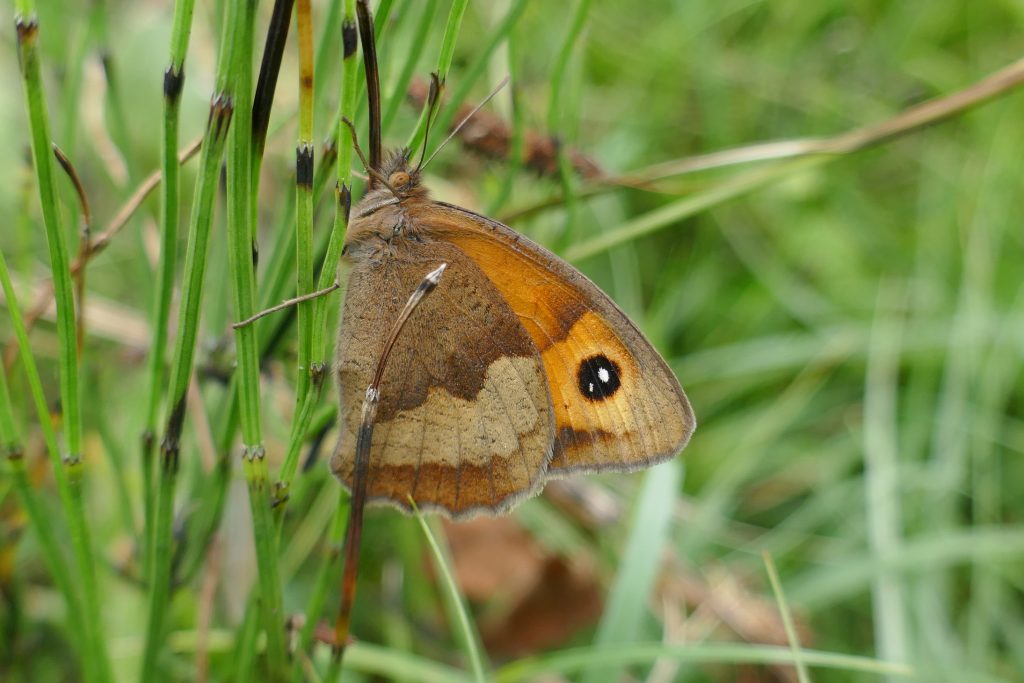The latest Irish Butterfly Monitoring Scheme report 2023 (Judge and Lysaght 2023) mentions the six most common butterflies recorded using butterfly transect recording.
1. Meadow Brown 7716
2. Speckled Wood 5678
3. Ringlet 3849
4. Small Tortoiseshell 3582
5. Peacock 2997
6. Green-veined White 2488
While 2023 lacked warm, dry summer weather after the end of June, populations of some species proved quite high. I was thrilled to see a great recovery in Peacock numbers, for example, which were much lower in 2022. The Small Tortoiseshell also featured in thrilling numbers during 2023 in the places I look for butterflies, chiefly south Meath and north-west Kildare.

The figures given above are taken from transects, not from casual recording. Transects are fixed route walks when counts are made each week from 1 April to 30 September or are made five times during this period.
Casual butterfly recording is recording butterflies seen in a location but without necessarily visiting that location regularly and probably not applying a standardised counting methodology. This does not mean that casual recording is not valuable. Casual recording is vital to obtain distributional data meaning it allows us to know where in a country butterflies occur. Furthermore, many casual recorders report their sightings from an area they visit regularly, so results can be broadly similar to those obtained when walking the fixed route used in a transect.
The records on the Butterfly Conservation Ireland record database are a mixture of transect records, records from regularly visited locations and records arising from one-off site visits.
As an imperfect, interim comparison exercise, we compiled the records Butterfly Conservation Ireland received of these six most common species from the beginning of 2024 to the end of August 2024 and ranked them numerically.
Here is what we found.
1. Meadow Brown 2225
2. Ringlet 1632
3. Speckled Wood 642
4. Green-veined White 526
5. Peacock 245
6. Small Tortoiseshell 188
While the Meadow Brown held the top spot, the other five species changed their placings. The crashes in the Peacock and Small Tortoiseshell populations are particularly striking.

The number of Small Tortoiseshell recorded in July 2023 (351) and for the Peacock in August 2023 (881) heavily underline this collapse. August 2023 saw more 72% more Peacock records than the first eight months of 2024. For the Small Tortoiseshell that figure is 46%. A comparison for both species using the full years will show even steeper drops.
We hope to bring you that analysis in our Annual Report 2024. For the Annual Report 2023, see https://butterflyconservation.ie/wp/butterfly-conservation-ireland-annual-report-2023/

We expect the figures for the Small Tortoiseshell and Speckled Wood to increase appreciably during September, a key month for both but the damage to the Small Tortoiseshell from April to August is too severe for its abundance to come close to last year’s population.
Several consecutive months (July 2023-April 2024, except February 2024) with heavy rainfall is the likeliest cause of the declines. While June and July 2024 had below-average rainfall in most places in Ireland, the temperatures were below average everywhere in July and nearly everywhere in June. In August 2024, the temperature was below average in most areas and rainfall varied widely, with Dublin Airport receiving 50% of its average rainfall, compared with areas in the west of Ireland which saw their wettest August since 1992 (Belmullet) and 1985 (Newport).

Two weather stations had their wettest August on record. These were Malin Head, Co Donegal with 181.3 mm (record length 69 years) and Knock Airport, Co Mayo with 215.4 mm (record length 28 years). The puzzling month is May 2024. Met Eireann reported May 2024 as the warmest on record; however, it was dull and overcast much of the time, with all available monthly sunshine totals below their long-term average. Direct sunshine is important for butterfly and moth larvae. Perhaps this deficiency added to the crisis.
I have yet to see a Small Tortoiseshell in my garden in 2024; I have seen this butterfly in my garden for each of the last 26 years. I hope for a September bailout. We could do with a burst of butterfly joy!
Key References
Judge, M and Lysaght, L. (2024). The Irish Butterfly Monitoring Scheme Newsletter, Issue 16. National Biodiversity Data Centre.
Past weather statements (2024) Met Éireann – The Irish Meteorological Service. Available at: https://www.met.ie/climate/past-weather-statements (Accessed: 03 September 2024).
All photographs J.Harding


We live in Co Waterford near the Comeragh Mountains.
We have been struck by the exremely low numbers of Small Tortoiseshell, Red Admiral and Peacock this year, all of which we have seen fewer that 10-20 in the whole of August.
We have been used to seeing dozens of each species in the past swirling in clouds when we walk past.
We have seen no Painted Ladies or Fritillaries at all.
The abundance crash is a national feature. It also occurred in Britain and northern Europe. The weather during 2023 and 2024 is being held responsible.